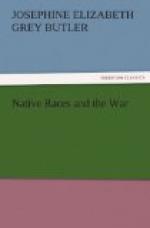The Aborigines Protection Society endorses the following statement of Sparrman (visit to the Cape of Good Hope, 1786, Vol. II, p. 165,) who says, “The Slave business, that violent outrage against the natural rights of man, which is always a crime and leads to all manner of wickedness, is exercised by the Colonists with a cruelty that merits the abhorrence of everyone, though I have been told that they pique themselves upon it; and not only is the capture of the Hottentots considered by them merely as a party of pleasure, but in cold blood they destroy the bands which nature has knit between husband and wife, and between parents and their children. Does a Colonist at any time get sight of a Bushman, he takes fire immediately, and spirits up his horse and dogs, in order to hunt him with more ardour and fury than he would a wolf or any other wild beast.”.
“I am far from accusing all the colonists,” he continues, “of these cruelties, which are too frequently committed. While some of them plumed themselves upon them, there were many who, on the contrary, held them in abomination, and feared lest the vengeance of Heaven should, for all their crimes, fall upon their posterity.”
The inability of the Amsterdam authorities to control the filibustering zeal of the colonists rendered it easy for the people at the Cape to establish among themselves, in 1793, what purported to be an independent Republic. One of their proclamations contained the following resolution, aimed especially at the efforts of the missionaries—most of whom were then Moravians—to save the natives from utter ruin: “We will not permit any Moravians to live here and instruct the Hottentots; for, as there are many Christians who receive no instruction, it is not proper that the Hottentots should be taught; they must remain in the same state as before. Hottentots born on the estate of a farmer must live there, and serve him until they are twenty-five years old, before they receive any wages. All Bushmen or wild Hottentots caught by us must remain slaves for life."[9]




